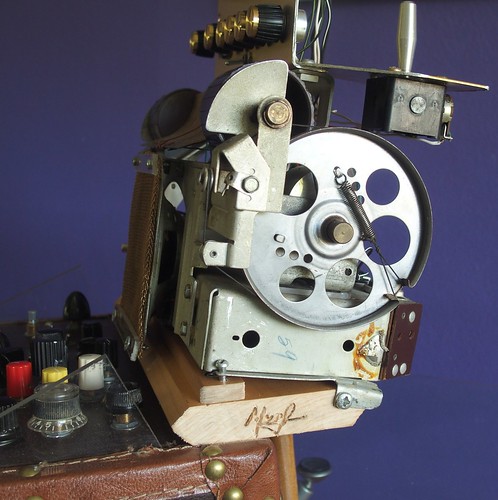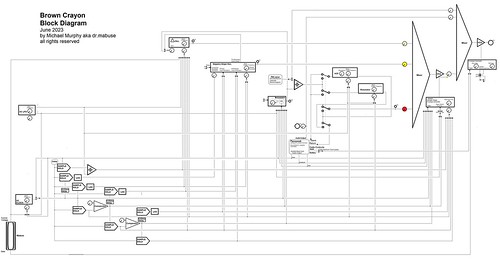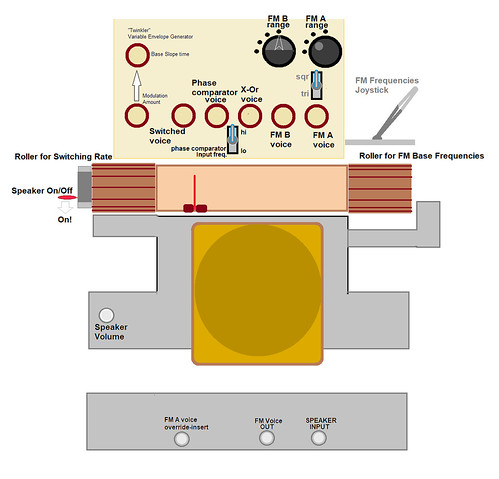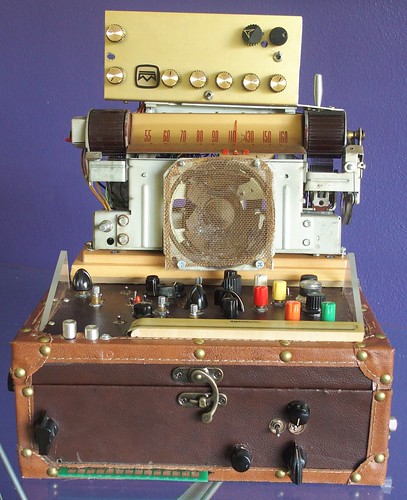The Brown Crayon
What’s in a name?
In the case of this electronium … plenty!
The reason this instrument is called ‘The Brown Crayon’ is Venus Slick.
Venus grew up (and I do mean UP.. she and her brothers are all 6 feet tall or taller!) as the only girl in a clump of 4 boys.
When crayons were distributed, her more-acquisitive brothers claimed all the good colors preemptively and they’d tell Venus, “Well….you can have THIS color” ….brown*.
Around 2001 Venus had been playing some synthesizer in the Tory Starbuck Project band. The T.S.P. thrives on juxtaposing formally-trained and not-formally trained muscians. Venus has no formal training in music but Tory wanted to expand her role in the arrangements.
Most synthesizers are controlled by a keyboard, and at the beginning of her tenure Tory tried to have Venus play rudimentary drones or simple motifs on keyboard synths.
She found this role distastefully restrictive and told Tory that she was not interested in “being stuck with the brown crayon” again in her life.
I was dazzled by that turn-of-phrase and (as a bass player) I resonated with the sentiment behind her quip. I had just finished a keyboardless electronium “Il Viaggio di Marconi” which I put in their hands and Venus took-to it like a swan takes to a big lake.
And I am duty bound to testify that Venus mastered that complex instrument in an astonishingly short time.
Fast-forward 25 years, and I decided to design another instrument for her (with a nod to her husband’s proclivities as well) and the enclosure I had with enough internal room for the musical engines I wanted to include was …..
….brown.
So the instrument was christened long before the design was finalized.
There aren’t enough brown synthesizers anyway!
Plopped on top of the box , is the chassis I scooped out of the 1948 RCA 8BX6 ‘Globetrotter’ radio enclosure that I used to house the Annoyance of Grackles.
The old saying is “they don’t make ’em like that anymore”….
Take look at the pulley mechanics of the linear tuning dial:
75+ years later, and it still works.
They don’t make ’em like THAT anymore.
There was a multi-gang variable capacitor that just screamed ‘Analog FM’ at my imagination and so I adapted the original radio tuning components as a control system for an FM’d Oscillator Pair. (There is a detailed block diagram below).
When I finished the instrument I decided to put it in on permanent loan to Tory & Venus’ collection.
In detail, there are 5 voices behind a touch-controlled VCA.
One of the voices is a modified PipSqueak design by Martin Freeman. The Pipsqueak is, itself, a touch-dependent design, so the Brown Crayon is a very hands-on instrument.
The Pipsqueak’s touch pads can be seen protruding from the lower left corner of the box.
Additionally, there is a joystick-controlled FM-Oscillator Pair, three quirky oscillators , a state variable VCF, two voltage controlled resonators. two envelope generators, and two VCA’s.
My intention was that this instrument be optimized for live performance by Tory & Venus so I eschewed patch-cords and used switches to route a matrix of eleven control voltage sources.
Because my intention was to hand this device to Tory & Venus ‘for keeps’ I felt obliged to document the panel controls to give them a fighting chance at mastering it.
A few miscellaneous features worth mentioning:
The assimilation of the old radio chassis naturally started with a ‘demolition’ phase wherein I removed the components that were in my way, broken, or toxic(!). As one would expect after the better part of a century, the speaker cone was mostly gone.
But I paused. I cut my teeth on the venerable Arp 2600 and one of the features I always loved about the 2600 was that it had on-board speakers and you could hear it without hassling with an outboard amplifier. So I decided to lightly “paint” the remaining fragments of the original radio speaker with silicone adhesive and pump a half-watt signal to the speaker. To my pleasant surprise the signal was intelligible. The fidelity was ….um…..idiosyncratic…but functional enough leave in place, to burnish the ‘distressed’ charm of the instrument. I could not restrain myself from putting a couple of LED’s behind the wreckage of the cone to spotlight this perversity. Which segues nicely into the next feature… namely, the way I approached LED indicators on this instrument. If you look at the lower box panel diagram you’ll see only one green LED (to the right of the yellow knob). This LED indicates the status of the ‘middle’ VCA which is a critical bottleneck in the design; important enough to merit it’s own LED. The rest of the LEDS illuminate the clear triangular acrylic ‘fins’ on each side of the lower box. It’s impossible to describe how visually striking this looks, but the visual aspect was not the only benefit. The lower box is made of rather-thick particle board that makes it difficult to shape & support small holes, and the top control panel was already very crowded. These acrylic ‘fins’ made it possible to display up to 16 LED indicators to a wide viewing angle with just two narrow slots.
This display method is not original, or even particularly modern . Ampeg used this method on their justly legendary Portaflex bass amplifiers in the mid 1960s.
Here’s a video of the way I implemented this on the Brown Crayon
*It should be noted that Venus went on to become an accomplished painter in the oil on canvas medium.








Comments are closed.